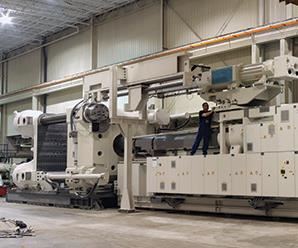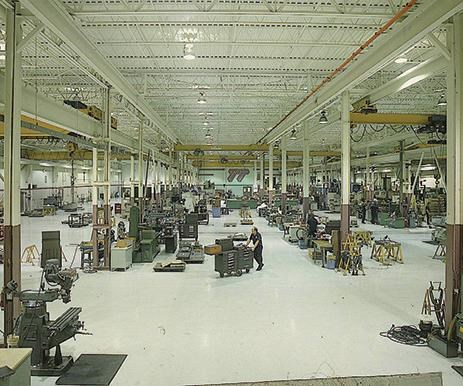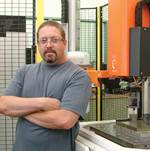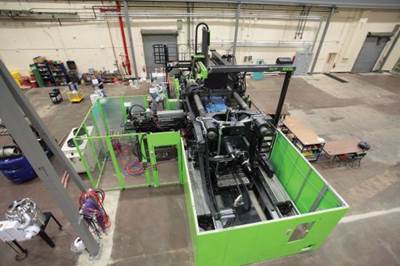Going Big in Coinjection
In-house sampling of the large coinjection molds it builds gives this moldmaker an edge over the competition.
Building very large molds is not necessarily a unique description of what a company does, but how many mold builders focus on building molds ranging from 400 tons to “unlimited size and weight?” Triangle Tool Corporation in Milwaukee, Wisconsin, does, and the company has built its reputation on it.
According to Daniel Gougé, vice president of sales, Triangle Tool’s early years were focused on building small molds for local customers. In 1968, Roy Luther came on board as plant manager, helping to lead the company’s growth. It wasn’t until 1981, however, when Luther became the sole owner, that the company concentrated on building really large molds. Customers come from such industries as appliances, consumer goods, returnable packaging, industrial, oil and gas, and transportation, and, according to Gougé, there are very few competitors who have the shopfloor space and equipment, plus the knowledge and capability, to build such large tools. This is a competitive edge that Triangle Tool works continually to maintain by investing in the latest machine tools and technologies in order to serve niche market applications. Its engineers design and build injection and coinjection molds, proprietary stack molds, structural foam molds, die cast tooling, forging dies, blow molds and more. The company also offers specialty machining for forging dies, large castings, bolster plates and weldments used by customers in wind, gas and oil, mining and the military.
Triangle Tool built its first coinjection mold about 10 years ago when a major OEM customer approached the shop about its need to manufacture large parts for the agricultural market. The success of this job spurred the company to begin acquiring equipment and resources to gain other customers who could benefit from the technology. Its expertise evolved from there. Today, it builds more than a dozen coinjection molds per year for customers in the appliance, agricultural, transportation and industrial markets, and coinjection molds make up about 10 percent of its business. Gougé says the company has added about 10,000 square feet to its now 220,000-square-foot building every year since 2008 in order to stay ahead of projected sales growth in coinjection molds, as well as growth in standard injection and structural foam molds.
Its most significant expansion occurred in 2013, when the company invested $6 million to grow the footprint of its mold manufacturing facility by 12,000 square feet and purchase a Krauss-Maffei Corporation 4,000-metric-ton coinjection molding machine, which is used for sampling the molds in house. This capability is what Gougé says gives Triangle Tool the edge over its competition.
“Anyone can build the mold, but being able to sample these large coinjection molds or other very large tooling has separated us from the pack,” he says. For example, the cost of transporting a mold between the shop and the customer can range between $5,000 and $15,000 each way, he says. “You can’t play in the large-mold game unless you can sample in house, saving the customer significant time and money, and ensuring they get a production-ready mold when it is delivered.”
Benefits of Coinjection
Coinjection molding is the process of injecting two different plastic materials almost concurrently into a mold via the same gate. The core material (generally recycled resin) becomes encapsulated by the outer virgin material, which, for Triangle Tool, is usually high-density polyethylene or polypropylene. Triangle uses what it calls the “ABA” method of filling, meaning first the “A” barrel pushes a designated amount of virgin material into the mold cores and shuts off. The “B” barrel, filled with melted recycled material, injects next, then shuts off. This is then followed by the final injection of virgin material, which seals the core material from the “B” barrel inside. With Triangle’s 4,000-metric-ton press, the A barrel can push a 50-pound shot of material while the B barrel can push a 20-pound shot.
Because the core material used in coinjection molding is comprised of recycled plastics, it is considered a very green and sustainable manufacturing process. But there are other benefits for parts made this way as well. For instance, the use of recycled plastics in the core of a part helps make the part stronger and more robust. Gougé says the best way to explain this benefit is by thinking of the part as having three plies rather than one. One would expect a three-ply material to be stronger. Recycled material also often is less than half the price of virgin material. And because the core material is essentially being “laminated” by virgin material in the coinjection process, Gougé says, it may allow further thinning of the walls of a part, leading to even more material cost savings.
“Cost savings for the molder and its downstream customer is a major benefit, especially when you consider the very large parts (vehicle hoods, for example) being molded,” he says.
The ratio of core material to virgin material depends on the part design. On a part with no decorative requirements, such as protection mats used in lumber and electrical industries to prevent damage to the ground underneath heavy equipment, one can push the limits on how much recycled resin is used, Gougé says, because “bleeding” of core material through the outer layer is not necessarily important. However, such bleeding through on a cap or closure would not be acceptable, he says.
According to Gougé, Triangle Tool has yet to fully grasp all the possibilities for using coinjection technology, because there are many, but over time, the company has come to understand what applications are not conducive to coinjection. One example is the addition of ribs into a cap design, which can cause bleed-out of the core material in the flow front during mold fill, he explains.
Additionally, he says that, unlike molds built for small, symmetrical parts like caps and closures, where flow fronts tend to be uniform, large molds like those Triangle Tool often builds typically have multiple wall geometries and long distances over which resin must flow, creating additional challenges.
Gougé admits that the upfront costs of coinjection can be large, but many customers see a return on their investments in less than a year. He still believes coinjection is a niche market that has room for growth, and Triangle Tool will continue to invest in the technology as customers demand it.
Related Content
Mold Design Review: The Complete Checklist
Gerardo (Jerry) Miranda III, former global tooling manager for Oakley sunglasses, reshares his complete mold design checklist, an essential part of the product time and cost-to-market process.
Read MoreHow to Improve Your Current Efficiency Rate
An alternative approach to taking on more EDM-intensive work when technology and personnel investment is not an option.
Read MoreThink Safety: Eliminate Hazards Throughout the Shop
The tooling community is taking advantage of new products for safer mold shops and molding facilities.
Read MoreTop 10 Topics to Cover During an ISO 9001 Manufacturing Audit
Take a look at this practical hands-on approach to conducting a quality audit.
Read MoreRead Next
Carving a Niche with Multi-Material Sampling
In-house commissioning of multi-shot plastic injection molds is expected to pay dividends for this moldmaker—and, perhaps more importantly, for its customers.
Read MoreMoldmaker/Molder “Doubles Down” with Technology Investment
“At a time when many others are exiting the domestic tool making business because of its low margins and ever growing requirements for capital investments, we see it as a critical component to the ultimate success of our customers’ end product in the market.”
Read MoreHow to Use Continuing Education to Remain Competitive in Moldmaking
Continued training helps moldmakers make tooling decisions and properly use the latest cutting tool to efficiently machine high-quality molds.
Read More























